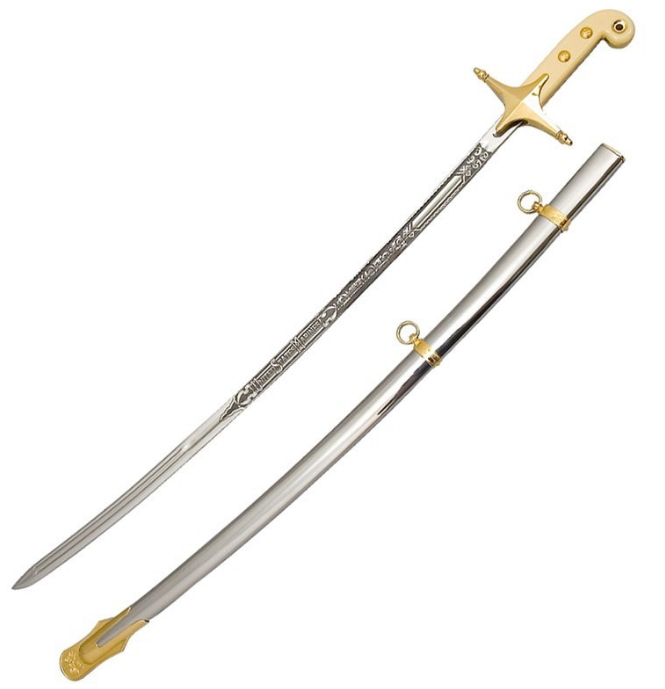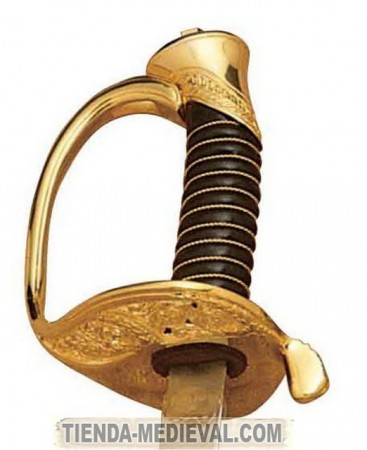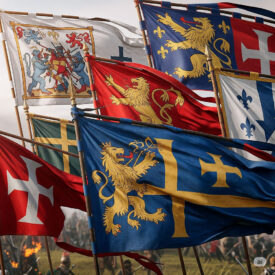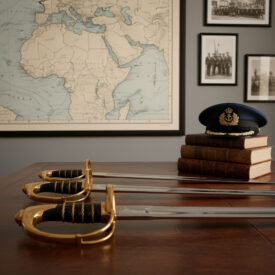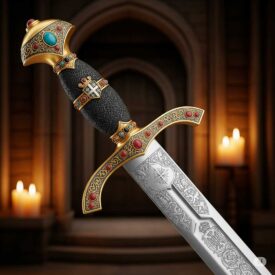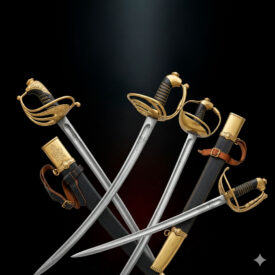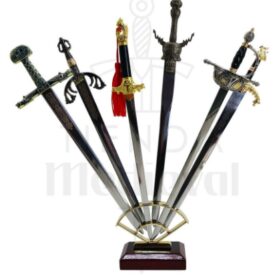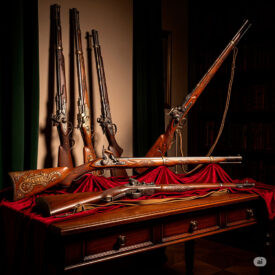Have you ever wondered what history lies within those imposing blades proudly carried by United States Marine Officers? More than just weapons, Marine sabers are emblems of an unbreakable tradition, symbols of honor and bravery forged over centuries. From victories in distant lands to the most solemn ceremonies, these pieces embody the spirit of one of the world’s most respected military forces.
If you are a collector passionate about military history or simply admire the elegance of these pieces, this guide is for you. You will embark on a fascinating journey to discover the key differences between certified replicas and original sabers, unraveling their secrets and understanding the deep meaning that each blade carries. Prepare to unveil the details that transform a simple replica into a museum-worthy piece.
The Steel Legacy: A Look at the History of the USMC Saber
| Era | Event |
|---|---|
| War of Independence (late 18th century) | |
| Initial patterns | It is believed that the sabers used by Marine NCOs were based on US Army patterns. |
| Mid-1820s — NCO Transition | |
| Mid-1820s | Marine NCOs begin using distinctive short sabers with cast brass eagle-head hilts. |
| 1820s — Introduction of the Mameluke for officers | |
| 1825 | Marine Corps Commandant, Archibald Henderson, adopts the Mameluke-style saber for officer use. |
| 1826 | Initial distribution of Mameluke sabers to officers is carried out. |
| 1859 — Pattern Change for Officers and NCO Standardization | |
| 1859 | A completely new pattern is introduced for officers: they are required to use the US Army’s Model 1850 infantry officer’s saber. That same year, a similar saber is authorized for Marine NCOs, known as Model 1859 (M1859). |
| 1859–1875 — Exception in Mameluke use | |
| 1859–1875 | Period when officers were required to use the Army’s Model 1850, marking an exception in the use of the Mameluke saber by officers. |
| Continuity of NCOs and officers’ return to Mameluke | |
| From 1859 to the present | The Model 1859 Marine NCO saber (with slight modifications over time) is the oldest continuously and uninterruptedly serviced weapon in the US inventory. |
| From 1875 to the present | From 1875, officers resumed the use of the Mameluke saber and have maintained that tradition until today, with the sole exception of a brief suspension during World War II. |
The United States Marine saber is not merely a decorative object. It possesses a rich tradition dating back to 1805, when victory in Tripoli, during the First Barbary War, culminated in the presentation of jeweled sabers to senior USMC officers. The design was inspired by the Mameluke pattern, a style that, although with European modifications, has been maintained to this day. The blade, longer and less curved than the original Turkish kilij, became a hallmark.
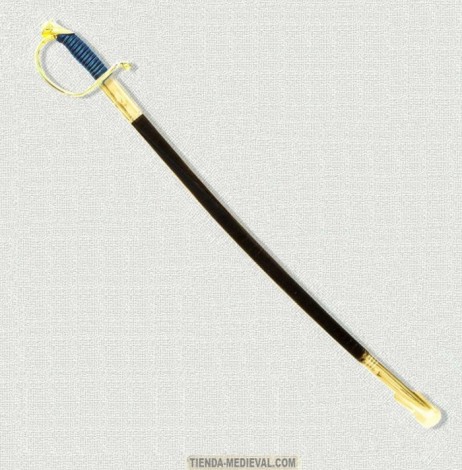 Today, Marine Corps officers continue to carry these sabers as a distinctive mark of rank, especially at events and ceremonies. Their symbolism is profound: the hilt represents Truth, while the curvature of the blade embodies Balance, Justice, and Peace. This symbolic weight makes it a highly valued collector’s item. A milestone in the history of these sabers was the adoption of the Mameluke style in 1825 by Commandant Archibald Henderson, marking a tradition that, apart from brief interruptions forced by conflicts, has endured to this day.
Today, Marine Corps officers continue to carry these sabers as a distinctive mark of rank, especially at events and ceremonies. Their symbolism is profound: the hilt represents Truth, while the curvature of the blade embodies Balance, Justice, and Peace. This symbolic weight makes it a highly valued collector’s item. A milestone in the history of these sabers was the adoption of the Mameluke style in 1825 by Commandant Archibald Henderson, marking a tradition that, apart from brief interruptions forced by conflicts, has endured to this day.
Official Sabers vs. Certified Replicas: Unraveling Authenticity
When we talk about Marine sabers, the distinction between a historical original and a quality replica is crucial for collectors. Both have their value, but their characteristics and purpose differ significantly.
Characteristics of the Original Officer’s Saber (Model 1859)
In 1859, a saber pattern emerged that, though similar, distinguished between officers and non-commissioned officers. The hilts of officer’s sabers were clad in exclusive sharkskin, and both these and the scabbard mounts sported elegant gold plating. Officer’s scabbards featured three mounts, two of which had rings for carrying, a clear sign of their status.
The Essence of Original Non-Commissioned Officer Sabers (Model 1859)
Non-commissioned officers’ sabers, on the other hand, featured simpler leather-wrapped hilts and plain brass scabbard mounts. The scabbards were characterized by having only two mounts, an upper one with a frog stud and a tip. This model of non-commissioned officer or NCO saber, introduced in 1859, holds the honor of being the oldest continuously and uninterruptedly serviced weapon in the US inventory.
Certified Authentic Replicas: A Tribute to the Legacy
High-quality replicas are not mere imitations, but pieces that honor history and official specifications. Manufactured in places with armory tradition such as Toledo (Spain) or Solingen (Germany), they combine traditional techniques and modern materials. They are characterized by:
- High-quality stainless steel blade, engraved with the legend “United States Marines”.
- Hilt with an elegant ivory imitation finish.
- Brass guard.
- Metal scabbard with brass finishes.
These replicas usually include certificates of authenticity and come in various lengths to suit the collector’s preferences. They are legal and comply with regulations, making them ideal for display and collecting.
The Art of Manufacturing: Forging a Marine Saber
The manufacturing of sabers, both original and quality replicas, is a process that demands mastery and artisanal precision. Forging is an art that combines traditional techniques with modern technology, resulting in pieces of exceptional beauty and durability.
The Collector’s Choice: Original or Replica?
Deciding between an original saber and a high-quality replica depends on your goals as a collector. Originals, with their proven provenance, can fetch considerable sums at auction, representing a significant historical investment. However, certified replicas offer an accessible and aesthetically impeccable alternative for those who value authenticity in design and materials.
For collectors, it is crucial to:
- Verify official certification: Always look for the manufacturer’s certificate of authenticity, especially for replicas.
- Research the manufacturer: Ensure it comes from reputable houses, such as WKC (Germany) or the artisans of Toledo (Spain).
- Consider the purpose: If you are looking for a piece to proudly display and connect you with Marine tradition, a quality certified replica is an excellent option.
- Maintenance and preservation: Regardless of your choice, a saber requires care. Store the blade and scabbard separately to prevent corrosion and clean regularly to maintain its splendor.
The collection of US Marine Corps sabers is a passionate journey that connects you with a legacy of bravery and honor. Whether you opt for the historical depth of an original or the impeccable craftsmanship of a certified replica, each saber is a declaration of respect for one of the world’s most emblematic military institutions.

